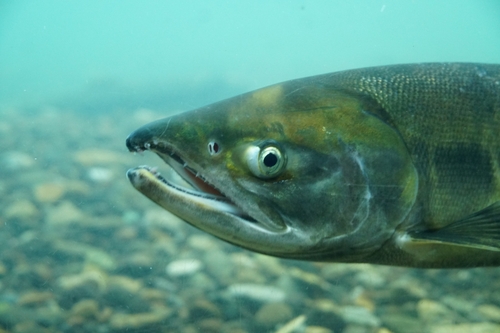
Chum Salmon
The Atlantic Bluefin Tuna (Thunnus thynnus) is a highly migratory, large pelagic fish known for its incredible speed, size, and commercial value. This apex predator plays a crucial role in the marine ecosystem. Its impressive physiology and life history have made it a subject of both scientific study and culinary fascination.
3 7 years
Lifespan
50 - 100 cm
Length
Least Concern
Conservation Status
25 km/h
Swimming speed
Carnivorous, Planktivorous
Diet
Highly Migratory, Anadromous
Migration
Appearance Overview
The Atlantic Bluefin Tuna is renowned for its large, streamlined body, built for speed and endurance.
Color
Dark metallic blue above, silvery white below
Body Shape
Torpedo-shaped, with a crescent-shaped tail
Fins
Two dorsal fins, the first depressible; small finlets behind dorsal and anal fins
Length
Up to 13 feet (4 meters)
Weight
Up to 2,000 lbs (900 kg)
Diet
Carnivorous, feeding on a variety of fish, squid, eels, and crustaceans.
Feeding Behavior
Highly active predator, often hunting cooperatively, using speed and agility to capture prey.
Social Behavior
Forms schools, sometimes segregated by size; known for long-distance migrations.
Commercial Relevance
Extremely high value, particularly in the sushi and sashimi markets; one of the most expensive fish species.
Conservation measures
Subject to international fishing quotas, stock management plans, and monitoring efforts; marine protected areas also contribute.
Status
Endangered (Varies by population)
Threats
Overfishing, driven by high demand for sushi; bycatch in other fisheries; climate change impacting prey availability.
Habitat Distribution
Depth Range
0-1,000 meters (0-3,280 feet), most commonly in epipelagic and mesopelagic zones.
Geographic Range
Western and Eastern Atlantic Ocean, Mediterranean Sea.
Preferred Environment
Temperate and subtropical waters; highly migratory, following prey and specific temperature ranges.
Reproduction and Life Cycle
Breeding Habits
Spawns in the Mediterranean Sea and the Gulf of Mexico; spawning is temperature-dependent, occurring in warm waters.
Development Stages
Eggs hatch into larvae; rapid growth in the first year; juveniles develop into adults, continuing to grow throughout their lives.
Fecundity
Females can release up to 30 million eggs per spawning season.
Maturity Age
Reaches sexual maturity at around 4-8 years in the Mediterranean, and later (8-12 years) in the Gulf of Mexico.
Faqs about Chum Salmon
How long do Atlantic Bluefin Tuna live?
Atlantic Bluefin Tuna can live up to 40 years, though this is becoming less common due to fishing pressure.
How fast can Atlantic Bluefin Tuna swim?
They are among the fastest fish in the ocean, capable of bursts of speed up to 43 mph (70 km/h).
Are Atlantic Bluefin Tuna warm-blooded?
Yes, they are warm-blooded, which helps them maintain high activity levels in cold waters.
What are the natural predators of Bluefin Tuna?
Their primary predators include sharks, orcas, and other large marine animals, and humans.
Is it legal to fish for Atlantic Bluefin Tuna?
Yes, strict regulations and quotas are in place, but illegal fishing remains a significant threat.
Where are Atlantic Bluefin tuna generally located?
They are found in the Atlantic ocean.
Copyright @ Nature Style Limited. All Rights Reserved.
 English
English